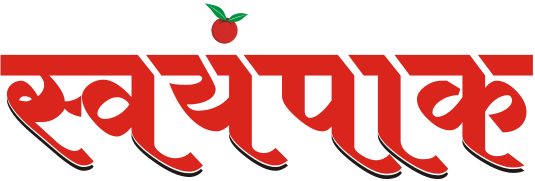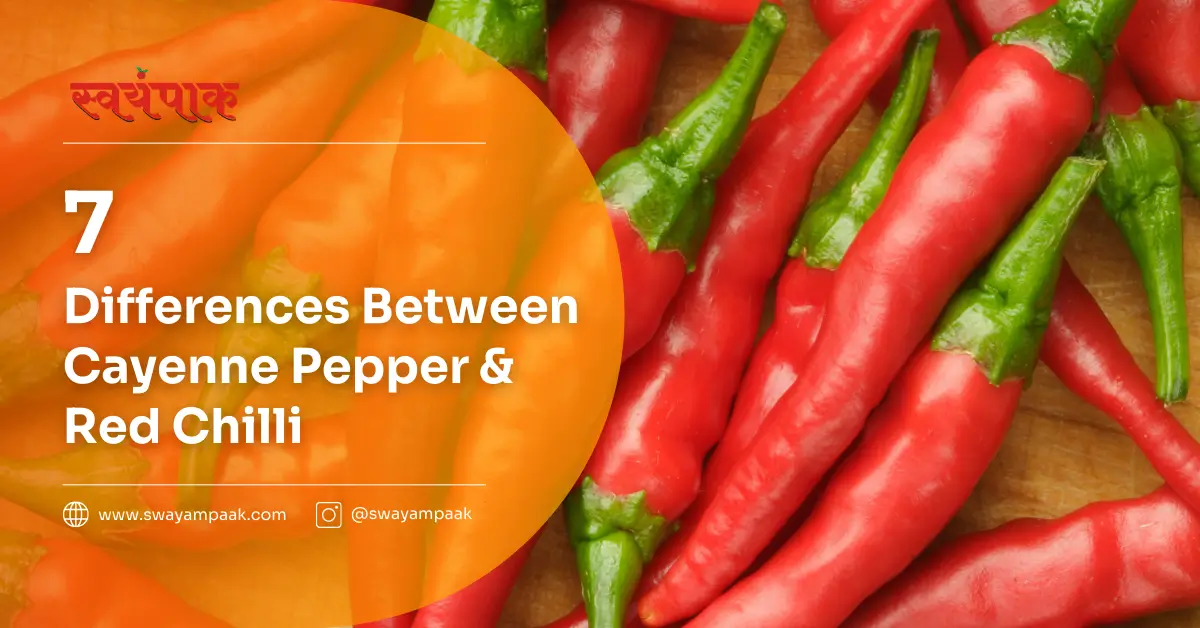When it comes to adding the right amount of heat to your favourite dishes, many home cooks are confused about whether to use cayenne pepper or red chilli.
In India, both of these bright spices are used all the time in the kitchen, but they each add something unique to your dishes.
Learning about these two spice powerhouses will change the way you cook, whether you’re making a traditional dal tadka in Mumbai or trying out international food in Delhi.
This in-depth guide about “Cayenne Pepper vs Red Chilli” looks at every part of cayenne pepper and red chilli, so you can make smart choices for meals that are healthier and taste better.
What are cayenne pepper and red chilli, exactly?
- Cayenne Pepper vs Red Chilli: Let's Compare
- Cayenne Pepper: The Heat Master
- Red Chilli: The Indian Favourite
- Nutritional Showdown Cayenne Pepper vs Red Chilli (per 100g)
- What Cayenne Pepper Has to Offer
- What Red Chilli Is Good For
- Cayenne Pepper vs Red Chilli: Heat Levels and Flavour Profiles
- When to Use Which in the Kitchen?
- Tips and Tricks for Cooking
- Things to think about for your health and safety
- Shopping Guide: What to Keep an Eye Out For?
- How to Store and How Long It Lasts?
- Rules for Substituting
- Different tastes in different parts of India
- The Verdict: Cayenne Pepper vs Red Chilli
- Things to think about and trends for the future
Cayenne Pepper vs Red Chilli: Let’s Compare
🌶️ Cayenne Pepper
🌶️ Red Chilli (Generic)
Cayenne Pepper: The Heat Master
Capsicum annuum, a type of chilli pepper, is where cayenne pepper comes from. It is usually ground into a fine, bright red powder. This spice is named after the French Guiana city of Cayenne. It has made its way into kitchens all over the world, even in Indian homes that want to keep the heat level the same.
Main Features:
- Bright red colour with a smooth texture – Consistency of fine powder
- The heat level is between 30,000 and 50,000 Scoville Heat Units (SHU).
- A flavour profile that is earthy and a little sweet – Potency that is the same across brands
Red Chilli: The Indian Favourite
In Hindi, red chilli is called “lal mirch.” It is a broad category of hot peppers that are widely used in Indian cooking. This group includes a lot of different types of chillies from different parts of India, like Kashmiri red chillies and Guntur chillies from Andhra Pradesh. Each one has its own level of heat and flavour.
Main Features:
- Comes in whole, dried, powdered, or crushed forms
- The colour can be anything from deep red to brick red.
- The heat levels can be very different (1,000 to 100,000+ SHU).
- The flavours can be mild and smoky or very hot.
- Different regions have their own unique varieties.
Nutritional Showdown Cayenne Pepper vs Red Chilli (per 100g)
What Cayenne Pepper Has to Offer
Per 100g serving
Health Benefits
- Metabolism booster: Capsaicin can raise thermogenesis, aiding weight management.
- Pain relief: Traditional use for arthritis and muscle pain.
- Heart health: May help lower blood pressure and improve circulation.
- Digestive support: Stimulates gastric juices and promotes healthy digestion.
What Red Chilli Is Good For
Per 100g serving (varies by type)
Health Benefits
- Immune support: High vitamin C content helps the immune system.
- Antioxidant powerhouse: Rich carotenoids protect cells from damage.
- Blood sugar regulation: May improve insulin sensitivity.
- Anti-inflammatory: Natural compounds can lower inflammation markers.
Cayenne Pepper vs Red Chilli: Heat Levels and Flavour Profiles
What the Scoville Scale Means in India
To help Indian taste buds understand these heat levels:
Mild Reference Points:
- Bell peppers (0 SHU)
- Kashmiri red chillies (1,000 to 2,000 SHU)
Medium Heat: – Cayenne pepper (30,000–50,000 SHU)
- Serrano peppers (10,000–25,000 SHU)
Bird’s eye chilli (50,000–100,000 SHU) is very hot.
- Guntur chillies (35,000–40,000 SHU)
Taste Traits
Cayenne Pepper:
- Heat that is clean and direct – Hints of earthiness
- Not very sweet – No smoky notes – Same flavour profile
Red Chilli (depends on the type):
- Flavours that are hard to describe
- Different types from different areas have their own tastes
- Can have a smoky, fruity, or strong smell, some kinds are sweet
- The heat and flavour levels are very different.
When to Use Which in the Kitchen?
What to Do with Cayenne Pepper?
Food from other countries:
- Sauces and gravies from around the world
- Seasonings for pizza and pasta
- Mexican and Tex-Mex dishes
- Marinades for grilled meats
Uses in India:
- Curries that need even heat
- Spice blends that need to stay strong
- Tandoori marinades
- Spices for street food
What to Do with Red Chilli?
Cooking in the Indian Way:
- Making pickles (achaar) and tempering (tadka) for different dishes
- Different kinds of traditional spice mixes (garam masala)
Specific Variety Applications:
- Kashmiri Red Chilli: Adds colour without too much heat
- Guntur Chilli: Adds a lot of heat to Andhra dishes
- Byadgi Chilli: Adds a lot of heat to Karnataka dishes
- Mathania Chilli: Adds a lot of heat to Rajasthani dishes
Tips and Tricks for Cooking
How to Use Cayenne Pepper?
How to Measure:
- For four servings, start with 1/4 teaspoon.
- Slowly raise the amount based on how much heat you can handle
- Mix with other spices to get the right flavour
How to Store:
- Keep in airtight containers
- Stay out of direct sunlight
- Stays potent for 2–3 years
Using Red Chilli
How to Prepare:
- Whole Dried: Take out the seeds to lower the heat
- Powdered: Sift to make the texture even
- Paste: Soak and grind for real flavours
Tips for Cooking in Your Area:
- Cooking from South India: Use with mustard seeds and curry leaves.
- Food from North India: Mix with garam masala
- Cooking in Bengali: Use mustard oil to temper for a unique taste
Things to think about for your health and safety
General Precautions
- If you’re not used to spice, start with small amounts.
- Don’t touch your eyes after handling it.
- Pregnant women should only eat a little.
- People with stomach problems should limit their intake.
Side Effects to Watch Out For:
- Sensitive people may have stomach problems
- Skin irritation from direct contact
- Possible drug interactions with blood thinners
- May cause acid reflux in people who are prone to it
Shopping Guide: What to Keep an Eye Out For?
- Choose well-known brands with clear labels.
- Look for products that are the same colour and have a fine texture.
- Stay away from products that are too moist.
- There are organic options for people who care about their health.
Buying Red Chilli
- Whole Dried: Look for bright colour and a few broken pieces.
- Powder: Check for real colour and smell.
- Regional Varieties: Get your supplies from traditional sources and check their authenticity with colour and heat tests.
How to Store and How Long It Lasts?
Best Storage Conditions
- A cool, dry place away from direct sunlight
- Airtight containers to keep potency
- Don’t put them in the fridge, which can add moisture
- Mark the containers with the date you bought them
Guidelines for Shelf Life:
- Whole Dried Chillies: 2–3 years
- Ground Spices: 1–2 years for best flavour
- Opened Packages: Use within 6–12 months
- Check for colour fading or loss of smell
Rules for Substituting
When You Can’t Find Cayenne Pepper:
- For every 1/4 teaspoon of cayenne, use 1/2 teaspoon of red chilli powder.
- Add it slowly as the heat level changes.
- Think about how the flavour will affect the final dish.
When Red Chilli Is Not Available:
- Use 1/4 teaspoon cayenne for 1/2 teaspoon red chilli powder
- You might need more colour with paprika.
- Change the amounts of the other spices to keep the flavour balanced.
Different tastes in different parts of India
North India: likes moderate heat levels, Kashmiri red chilli for colour, and cayenne pepper in modern city cooking.
South India
- Can handle more intense heat
- Uses traditional types like Guntur and Byadgi
- Uses complex spice blends with different types of chilli
West India
- A balanced approach to heat and flavour
- Maharashtrian food uses a certain local type
- International spice types are becoming more popular
East India
- Likes moderate heat
- Focuses on smel
- Uses traditional mustard oil-based recipes
The Verdict: Cayenne Pepper vs Red Chilli
In the end, the choice between cayenne pepper vs red chilli depends on what you need for cooking, how much heat you can handle, and what you like the taste of. Think about these things:
When to Use Cayenne Pepper: When you need heat levels that are always the same
- Making food from around the world
- Need a fine texture for sauces that are smooth
- Want heat without too many flavours
When to Use Red Chilli:
- When making traditional Indian food
- When you want to be true to the region
- When you want flavours that are hard to pin down
- Need certain colour traits
Things to think about and trends for the future
Cayenne pepper vs red chilli will always be an important debate point in Indian cuisine. People in cities are starting to like cayenne pepper more and more because it is easy to use and always tastes the same. Traditional cooks still like the real flavours of regional red chilli varieties.
Both spices are also popular with Indian consumers because they are becoming more health-conscious and they know that they are good for metabolism, immunity, and overall health. Cayenne pepper has a simple heat, while red chilli has a more complex flavour. Both will continue to improve Indian kitchens for years to come.
Always choose the spice that makes you happy when you cook and makes you happy when you eat. Try both out to find out what you like best and make meals that your family and friends will remember.


